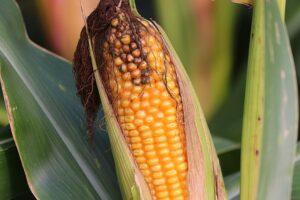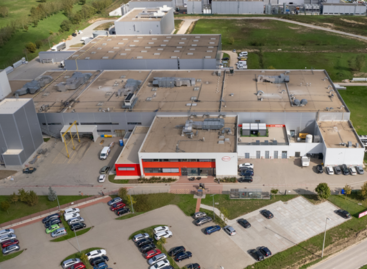Challenges in Hungarian Grain Production: Focus on Quality and Sustainability
At the Portfolio Agrárszektor 2024 Conference, industry experts revealed that 60% of Hungary’s corn harvest is unsuitable for food production, leading to a loss of key export markets, including Italy. Although this year’s drought was less severe than in 2022, its impact on corn production has been more damaging. Experts highlighted the need for a national irrigation strategy and a shift in focus toward producing premium-quality crops to ensure competitiveness in the global market – Agrárszektor points out.
The State of Corn and Wheat Production
 The conference revealed alarming trends in Hungarian agriculture:
The conference revealed alarming trends in Hungarian agriculture:
- Corn: About 40% of the 2023 corn harvest is so heavily contaminated that it cannot even be used for dairy cattle feed. This has caused significant concern among feed producers, who plan to purchase more wheat and less corn next season.
- Wheat: Only 10-15% of Hungary’s wheat harvest was suitable for milling, while the rest was classified as feed or lower-quality grain. The lack of premium-grade wheat has forced experts to call for a shift from high-yield, low-quality crops to high-quality, lower-yield varieties to meet market demands.
A Market Under Pressure
Zoltán Reng, CEO of Hungrana Kft., emphasized that while Hungarian corn prices have detached from global market trends, they remain at higher levels than international averages. He warned that failing to produce sufficient quality to meet domestic processing needs could result in long-term decline for Hungarian agriculture. Reng also highlighted that irrigation plays a critical role in improving yields and should be addressed at a national strategic level rather than left to individual enterprises.
Zoltán Lakatos, CEO of Hajdú Gabona Zrt., echoed these concerns, noting that the divergence in domestic and export prices for corn and wheat reflects broader challenges in the grain market. He cautioned against inflating wheat prices to unsustainable levels, as it would harm all stakeholders in the industry. Lakatos further predicted that climate change could shift corn production zones northward, potentially leaving Hungary grappling with persistent contamination issues, such as aflatoxin.
The Impact of Climate and Regulation
Tamás Andréka, State Secretary at the Ministry of Agriculture, outlined regulatory changes affecting land use and property registration:
- New rules simplify land acquisition for young farmers, offering concessions for their first 10 hectares of arable land, pasture, meadow, or forest.
- Future lease agreements will no longer include clauses specifying agricultural techniques or crop types, providing greater flexibility to farmers.
- The transition to electronic land registration aims to streamline administrative processes, reduce processing times, and increase digital interactions with land management authorities.
These regulatory changes are expected to ease some of the administrative burdens on farmers while fostering a more modernized agricultural framework.
Global and Regional Market Uncertainty
The conference also addressed global market instability caused by geopolitical tensions, such as the Russia-Ukraine war, fluctuating EU economic policies, and declining Chinese demand. Gábor Berkes, CEO of Cargill Hungary Zrt., noted that while Hungary’s corn production faces quality challenges, neighboring countries like Romania and Bulgaria have suffered even worse yields. Berkes emphasized the need for long-term strategies to address regional issues like contamination and climate-related risks.
Insurance and Risk Management
Szabolcs Baranyi, Head of Agricultural Business at Groupama Biztosító Zrt., discussed the importance of agricultural insurance in mitigating risks. While weather conditions have reduced insurer revenues this year, premium rates have begun to rise. Baranyi encouraged farmers to embrace insurance as a critical tool, highlighting that varying yields across plots often reflect differences in risk management and cultivation practices.
Future Outlook
Looking ahead to 2025, experts presented mixed forecasts for grain prices:
- Reng Zoltán expects stable or declining prices, citing weak European and Chinese demand coupled with strong U.S. production.
- Lakatos Zoltán anticipates prices similar to current levels.
- Baranyi Szabolcs predicts price increases.
- Berkes Gábor, however, foresees potential price drops.
Bene Zoltán, Managing Director of Karintia Kft., emphasized that there will always be demand for premium-quality wheat, which commands higher prices. He urged a shift from quantity-focused production to quality-oriented cultivation, aligning with changing market demands.
A Call for Strategic Change
The conference underscored the urgent need for systemic reforms in Hungarian agriculture, from irrigation infrastructure and quality-focused crop selection to better risk management and regulatory modernization. As climate change and market instability reshape the agricultural landscape, the future of Hungarian grain production depends on the industry’s ability to adapt and compete with regional and global players.
Related news
Too many gifts, too much food: our holiday excesses are putting a serious strain on the environment
🎧 Hallgasd a cikket: Lejátszás Szünet Folytatás Leállítás Nyelv: Auto…
Read more >Lidl Austria Expands Electric Supply Fleet
🎧 Hallgasd a cikket: Lejátszás Szünet Folytatás Leállítás Nyelv: Auto…
Read more >Henkel: 3,000 accident-free days
🎧 Hallgasd a cikket: Lejátszás Szünet Folytatás Leállítás Nyelv: Auto…
Read more >Related news
Christmas shock in commerce: for the first time, we can pay with bank cards in fewer places
🎧 Hallgasd a cikket: Lejátszás Szünet Folytatás Leállítás Nyelv: Auto…
Read more >Hungarian Confectionery Manufacturers Association: trends in 2025 and prospects for 2026
🎧 Hallgasd a cikket: Lejátszás Szünet Folytatás Leállítás Nyelv: Auto…
Read more >Most grocery chains will be open until noon on December 24th
🎧 Hallgasd a cikket: Lejátszás Szünet Folytatás Leállítás Nyelv: Auto…
Read more >






